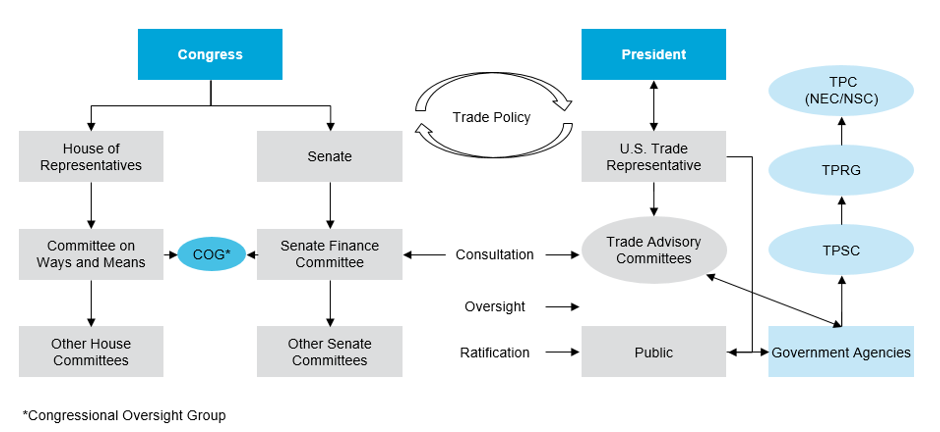
The Role of the US Trade Representative and the Legal Framework for Formulation of US Trade Policy
This report is the first of a series in which White & Case's International Trade Group will examine the Biden administration's trade agenda and the key institutions that shape US trade policy.
10 min read
On February 25, the Senate Finance Committee held a hearing on the nomination of Ms. Katherine Tai to serve as United States Trade Representative (USTR).1 The hearing followed the recent appointments of 13 individuals to serve in senior staff positions at USTR, announced on February 8.2
There is considerable interest in how members of President Biden's administration will shape the US trade agenda going forward, particularly given the unprecedented shifts in US trade policy and the multilateral trading system in recent years. USTR, a creation of Congress that is part of the Executive Office of the President, plays a central role in the development, implementation and enforcement of US trade policy. Understanding the mission of the USTR, as well as its statutory role in the broader legal framework and interagency process for formulating US trade policy is of critical importance when considering how personnel decisions may influence the direction of policy.
The US Legal Framework for Trade Policy Formulation
In the United States, as in most countries, trade policy is a central component of economic policy and foreign policy. Trade policy is frequently discussed in terms of its impact on employment, wages, and industrial competitiveness. However, US policymakers and the Congress have long recognized that trade policy has broader implications, including for national security, the environment, innovation and technology policy, and public health, among other considerations. Trade policy decisions necessarily impact a broad and diverse range of stakeholders within and outside the US government. The US legal framework for the formulation of trade policy attempts to accommodate these varied, overlapping, and sometimes competing interests.
The foundation for US trade policy starts with the Constitution. Article I, Section 8 of the US Constitution gives Congress authority over the key levers of trade policy, including the power to impose duties and to otherwise "regulate Commerce with foreign Nations[.]" At the same time, the President has broad authority under Article II of the US Constitution to conduct foreign affairs, including the power to negotiate international treaties with the advice and consent of the US Senate.
Given this constitutional framework, the advancement of US trade priorities requires cooperation and compromise between Congress and the Executive Branch. For example, Congress, under a series of laws, including the Trade Act of 19743 and various subsequent iterations of trade promotion authority ("TPA"), has delegated to the President the authority to negotiate trade agreements involving the reduction of tariff and non-tariff barriers, subject to certain statutory negotiating objectives and consultation requirements. Under TPA, Congress retains its authority to approve or reject the agreements negotiated by the President, though it commits to do so via an "up-or-down" vote within specified timeframes. This enables the President to negotiate trade agreements credibly and effectively through his foreign affairs powers under Article II without having to achieve the 2/3 majority in the Senate that is needed to approve a treaty.
Congress has also played a key role in establishing the Executive Branch entities and processes that are involved in the formulation of trade policy. In the Trade Expansion Act of 1962, Congress called for the President to appoint a "Special Representative for Trade Negotiations," which later became the USTR.5 Through subsequent legislative actions, Congress significantly expanded USTR’s responsibilities, elevated the USTR to a cabinet-level position within the White House, and placed USTR in charge of the interagency process for the development and coordination of US trade policy.6
The Role of the Office of the United States Trade Representative (USTR)
The US Trade Representative is a Cabinet-level official with the rank of Ambassador. The USTR serves as the President's principal trade adviser and negotiator, and is the chief US spokesperson on trade. USTR's mission is to obtain foreign market access for US goods and services through the negotiation of trade agreements and, where necessary, enforcement initiatives. More broadly, USTR is responsible for coordinating, developing, and implementing trade policy through an interagency process as well as stakeholder engagement and outreach. USTR’s role in the broader legal framework for the formulation of US trade policy is depicted in the flowchart below.
Interagency Process for Trade Policy
Given the wide range of interests implicated by trade policy, a key role of the USTR is to coordinate an interagency process to ensure that the Executive Branch can reach consensus and resolve policy disagreements.7 Within the guidelines set by the laws enacted by Congress, overarching trade policy decisions of the Executive Branch are made by the President and his Cabinet, including the USTR, whereas the task of animating broad principles is developed at the Deputy, Undersecretary and Assistant Secretary level and fleshing out detailed policy positions is carried out at the agency staff level. Even at the lower levels of the process, where decisions are guided by overarching policy mandates from higher levels, there are often significant disagreements and competing viewpoints among the agencies.
The coordination of trade policy across US Government agencies occurs through the following three-tiered interagency structure:
Tier 1: Trade Policy Staff Committee (TPSC)
The TPSC is administered and coordinated by USTR. Its members are drawn from subcabinet, senior civil servant level staff from 20 member agencies, including the Departments of State, Treasury, Commerce, Justice, Interior, Labor, Health and Human Services, Agriculture, Energy, and Transportation, as well as the Environmental Protection Agency, the National Economic Council, the National Security Council, and the Office of Management and Budget, among others. There are more than 90 TPSC subcommittees responsible for specialized areas and several task forces that work on particular issues. Among other activities, the TPSC develops policy papers, holds meetings, and solicits input from the public through hearings and requests for written comments.
Tier 2: Trade Policy Review Group (TPRG)
When agencies cannot reach consensus on an issue at the TPSC staff level, the issue is elevated to the TPRG, which is comprised of Deputy- and Undersecretary-level officials. This is not uncommon, though efforts are made to avoid elevating issues (e.g., through successive TPSC meetings).
Tier 3: Trade Policy Committee (National Economic Council (NEC) / National Security Council (NSC))
Unresolved issues of the greatest importance are elevated to Cabinet-level officials for resolution. Coordination at this level is carried out by members of the National Economic Council and the National Security Council. These officials are responsible for resolving disagreements among agencies and making recommendations to the President.
Private Sector Trade Advisory Committees and Stakeholder Engagement
The trade advisory committee system, established by Congress in the Trade Act of 1974, was created to ensure that US trade policy and trade negotiating objectives adequately reflect US public and private sector interests.8 Advisory committee members represent the full span of US economic interests, including manufacturing; agriculture; digital trade; intellectual property; services; small businesses; labor; environmental, consumer and public health organizations; and state and local governments.
The trade advisory committees provide information and advice on US negotiating objectives, the operation of trade agreements, and other matters arising in connection with the development, implementation, and administration of US trade policy. The advisory committee system is organized into three tiers:
- The President’s Advisory Committee on Trade Policy and Negotiations consists of members appointed by the President, and typically is composed of CEOs representing a diverse range of industries and stakeholders.
- There are five Policy Advisory Committees (dealing with environment, labor, agriculture, Africa, and state and local governments), the members of which are appointed by USTR alone or in conjunction with other Cabinet officers.
- There are 20 Technical and Sectoral Advisory Committees in the areas of industry (ITACs) and agriculture (ATACs). Each committee is comprised of individuals with subject-matter expertise in a particular sector or policy area (e.g., services, intellectual property, energy, chemicals, and animal products). Members of these committees are appointed jointly by USTR and the Secretaries of Agriculture and Commerce.
Outlook
Historically, input from Congress and the interagency and advisory committee processes have played important roles in the formulation of US trade policy. Not all administrations have approached trade policymaking in same way, however. During the Trump administration, the White House played a more assertive role in the formulation of trade policy—a signature campaign issue for President Trump—with input from Congress, the interagency process, and external stakeholders taking on less significance than in the past. It is expected that the Biden administration will return to a more traditional approach in which trade policy decisions are more often deliberated through the interagency process and consultations with Congress and other stakeholders play a more prominent role.
President Biden’s nominee for USTR, Ms. Katherine Tai, has significant experience representing Members of Congress in discussions with the Executive Branch concerning trade policy. In her recent position as Chief Trade Counsel to the House Ways and Means Committee, Ms. Tai was actively involved in consultations with USTR concerning the US-Mexico-Canada Agreement and other trade issues. She is also intimately familiar with USTR's mission, the dynamic of its internal operations and its central role in coordinating the interagency process from her time as chief counsel for China trade enforcement and as associate general counsel at USTR under the Obama administration. In addition, Ms. Tai understands the collaboration that Congress will expect in connection with future trade negotiations, the possible renewal of TPA, and other potential trade actions.
This experience was evident during Ms. Tai's confirmation hearing before the Senate Finance Committee. The hearing revealed little about the specific trade policies the Biden administration intends to pursue, including with respect to the trade conflict with China, possible efforts to join the CPTPP and WTO reform. Rather than offer a specific course of action on these and several other issues raised during the hearing, Ms. Tai instead focused on the broad principles and approaches that would guide her decision-making. Her responses placed heavy emphasis on consultations with Congress, other Executive Branch agencies and the public to inform trade policy decisions and balance the interests of different stakeholders. Ms. Tai cited this as a key distinction between her approach to trade policymaking and the approach taken by her predecessor, which she noted caused "a lot of disruption and consternation." She expressed her desire "to accomplish similar goals in a more effective, process-driven manner." Her extensive prior experience working with Congress may be a key factor if the Biden administration decides to seek an extension or renewal of the TPA which is set to expire this June.
The Finnce Committee voted to advance Ms. Tai’s nomination on March 3, and Ms. Tai is expected to be confirmed with broad bipartisan support. Katherine Tai’s tenure as USTR portends close collaboration between Congress and the Biden administration and a more robust interagency process with respect to the formulation of trade policy.
1 https://www.finance.senate.gov/hearings/hearing-to-consider-the-nomination-of-of-katherine-c-tai-of-the-district-of-columbia-to-be-united-states-trade-representative-with-the-rank-of-ambassador-extraordinary-and-plenipotentiary
2 https://ustr.gov/about-us/policy-offices/press-office/press-releases/2021/february/office-us-trade-representative-announces-key-staff-appointments
3 19 USC. § 2101 et seq.
4 The most recent iteration of TPA, the Bipartisan Congressional Trade Priorities and Accountability Act of 2015, is codified at 19 USC. § 4201 et seq. The TPA authority provided to the President by the 2015 Act expires on June 30, 2021.
5 19 USC. § 1801 et seq.
6 Section 141 of the Trade Act of 1974 provided a legislative charter for the “Special Representative for Trade Negotiations” as part of the Executive Office of the President, making it responsible for the trade agreements programs under the Tariff Act of 1930, the Trade Expansion Act of 1962, and the 1974 Act. Section 1601 of the Omnibus Trade and Competitiveness Act of 1988 gave the “primary responsibility” for developing and coordinating US international trade policy.
7 The interagency process was first established pursuant to Section 242 of the Trade Expansion Act of 1962 (19 USC. § 1872).
8 19 USC. § 2155
White & Case means the international legal practice comprising White & Case LLP, a New York State registered limited liability partnership, White & Case LLP, a limited liability partnership incorporated under English law and all other affiliated partnerships, companies and entities.
This article is prepared for the general information of interested persons. It is not, and does not attempt to be, comprehensive in nature. Due to the general nature of its content, it should not be regarded as legal advice.
© 2021 White & Case LLP



